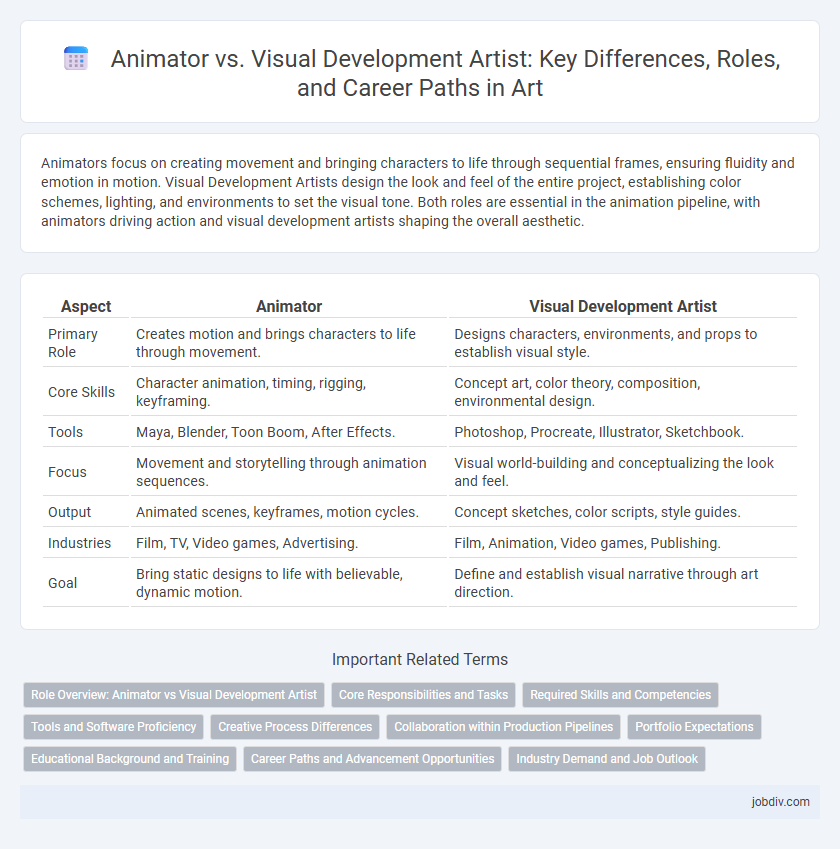Animators focus on creating movement and bringing characters to life through sequential frames, ensuring fluidity and emotion in motion. Visual Development Artists design the look and feel of the entire project, establishing color schemes, lighting, and environments to set the visual tone. Both roles are essential in the animation pipeline, with animators driving action and visual development artists shaping the overall aesthetic.
Table of Comparison
| Aspect | Animator | Visual Development Artist |
|---|---|---|
| Primary Role | Creates motion and brings characters to life through movement. | Designs characters, environments, and props to establish visual style. |
| Core Skills | Character animation, timing, rigging, keyframing. | Concept art, color theory, composition, environmental design. |
| Tools | Maya, Blender, Toon Boom, After Effects. | Photoshop, Procreate, Illustrator, Sketchbook. |
| Focus | Movement and storytelling through animation sequences. | Visual world-building and conceptualizing the look and feel. |
| Output | Animated scenes, keyframes, motion cycles. | Concept sketches, color scripts, style guides. |
| Industries | Film, TV, Video games, Advertising. | Film, Animation, Video games, Publishing. |
| Goal | Bring static designs to life with believable, dynamic motion. | Define and establish visual narrative through art direction. |
Role Overview: Animator vs Visual Development Artist
Animators specialize in creating movement by bringing characters and objects to life through frame-by-frame sequencing and keyframe techniques, ensuring fluid and expressive motion in films or games. Visual Development Artists focus on conceptualizing the overall look and feel of a project, designing characters, environments, color schemes, and lighting to establish a cohesive artistic direction. Both roles require strong artistic skills, but animators emphasize dynamic storytelling through motion, while visual development artists concentrate on pre-production design and atmosphere creation.
Core Responsibilities and Tasks
Animators specialize in bringing characters and scenes to life through motion, focusing on timing, expression, and fluidity using software like Maya or Blender. Visual Development Artists concentrate on the conceptual design of environments, characters, and props, establishing the visual style and mood with tools such as Photoshop and SketchBook. Both roles require strong storytelling skills, but animators emphasize movement and emotion, while visual development artists prioritize aesthetic design and atmosphere creation.
Required Skills and Competencies
Animators require strong skills in character movement, timing, and storytelling, with proficiency in software like Adobe Animate, Toon Boom, or Maya to bring characters to life. Visual Development Artists excel in concept art, color theory, lighting, and environment design, often utilizing tools such as Photoshop and Procreate to create mood and visual style. Both roles demand a solid understanding of anatomy, composition, and creativity but differ in focus--animators concentrate on motion and performance, while visual development artists emphasize visual mood and world-building.
Tools and Software Proficiency
Animators primarily utilize software such as Autodesk Maya, Toon Boom Harmony, and Adobe After Effects to create fluid motion graphics and character animations. Visual development artists focus on tools like Adobe Photoshop, Corel Painter, and Procreate to design environments, characters, and color palettes that establish the visual tone of a project. Mastery of these specialized software platforms directly influences the efficiency and quality of their respective creative outputs.
Creative Process Differences
Animators focus on bringing characters to life through movement, emphasizing timing, motion, and expression in sequential frames to evoke emotion and narrative impact. Visual Development Artists concentrate on establishing the aesthetic, mood, and atmosphere by designing environments, color schemes, and visual motifs that define the overall look of a project. The creative process of animators is dynamic and iterative, centered around storytelling through action, while visual development artists engage in exploratory and conceptual phases to shape the visual identity before animation begins.
Collaboration within Production Pipelines
Animators and Visual Development Artists collaborate closely within production pipelines to ensure cohesive storytelling and aesthetic consistency. Visual Development Artists establish the foundational style and mood through concept art, which guides animators in creating fluid character movements and expressive performances. Effective communication and iterative feedback between these roles optimize workflows and elevate the overall quality of animated projects.
Portfolio Expectations
A portfolio for an Animator emphasizes fluid character movement, timing, and storytelling through sequential frames or clips showcasing a range of expressions and actions. Visual Development Artist portfolios highlight concept art, color theory, environment design, and mood boards that establish the visual style of a project. Both require strong foundational skills in anatomy and perspective, but Animators prioritize motion skills, while Visual Development Artists focus on world-building and atmosphere.
Educational Background and Training
Animators typically hold a degree in animation, fine arts, or digital media, emphasizing courses in character movement, storytelling, and software proficiency such as Autodesk Maya or Adobe After Effects. Visual Development Artists often pursue studies in illustration, concept art, or graphic design, focusing on skills in color theory, composition, and environments using tools like Photoshop and Procreate. Both roles benefit from specialized workshops, internships, and continuous practice to master industry-standard techniques and software.
Career Paths and Advancement Opportunities
Animators specialize in creating motion and bring characters to life through frame-by-frame or digital animation techniques, often advancing to roles like lead animator or animation director. Visual Development Artists focus on designing environments, characters, and color scripts, with career growth leading to senior concept artist or art director positions. Both paths offer opportunities in film, gaming, and advertising industries, emphasizing creativity, technical skill, and collaboration.
Industry Demand and Job Outlook
Animators and Visual Development Artists each play crucial roles in the entertainment industry, with animators focusing on bringing characters to life through motion and visual development artists creating concept art and visual styles for projects. Current industry demand shows a growing need for skilled visual development artists due to the increasing importance of pre-production and concept visualization in animation, film, and gaming sectors. Job outlook projections indicate steady growth for both roles, though visual development artists often see higher demand in early-stage project development, while animators are essential throughout production and post-production phases.
Animator vs Visual Development Artist Infographic

 jobdiv.com
jobdiv.com